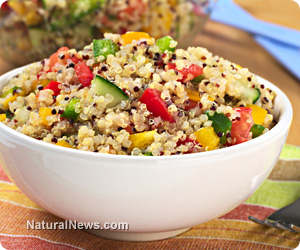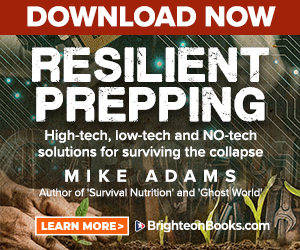
Quinoa questionable as a gluten free grain
Sunday, October 27, 2013 by: Anita Khalek
Tags: quinoa, gluten-free, foods
- Newly released JFK files reveal Pentagon's role in creating Lyme disease and covid in the same lab
- BIGGEST SCAM: You pay income tax, then taxes on purchases, then personal property tax on what you own that you already paid taxes on with taxed money
- Analysis: The coming economic collapse, a mass uprising and Trump's three secret weapons to halt the growing revolt
- American food is the MOST TOXIC “FOOD” on earth
- EXPOSED: Antifa and IRS collude to shield radical funding from taxation
- The flu vaccine paradox: Are we making things worse?
- Big Pharma's $8 Billion bribery scheme exposed: how doctors are pushed to prescribe junk science, not heal
- A lack of integrity in Academia: Harvard professor found GUILTY of fraudulent research to promote CRT theory
- Heads up! List of food shortages expected in 2025 as the campaign of forced starvation continues to be waged against the American people
- Florida takes a stand: DeSantis proposes permanent ban on mRNA vaccine mandates
- Discovery of Texas GOP representative living in retirement home amid health challenges and congressional absence sparks uproar
- Beyond consequence
- Reclaim your health: How midlife exercise reverses years of inactivity
- 5 Simple steps to boost your brainpower: How to strengthen executive function in a distracted world
- Government seizes millions of pounds of food amid global crisis
- Mike Adams Sermon 66: God will DESTROY ISRAEL for its wickedness
- Boys are back in town: Trump’s patriotic alpha crew takes the wheel while toxic females ride in the backseat
- Trump reverses course on Gaza plan, says “nobody is expelling Palestinians”
- Reclaim your health: How midlife exercise reverses years of inactivity
- A lack of integrity in Academia: Harvard professor found GUILTY of fraudulent research to promote CRT theory
- Space war brewing? Russia threatens to destroy Starlink satellites
- EPA advisor admits the agency is funneling billions to climate groups ahead of Trump’s return to White House
- Elon Musk: Aliens could be here on Earth RIGHT NOW
- Big Pharma's $8 Billion bribery scheme exposed: how doctors are pushed to prescribe junk science, not heal
- Historian warns Israel may be entering an “IRREMEDIABLE DECLINE”
- Trump reverses course on Gaza plan, says “nobody is expelling Palestinians”
- Mike Adams Sermon 66: God will DESTROY ISRAEL for its wickedness
- Rep. Nancy Mace introduces bill to ban biological males from female facilities on federal property
- New York politicians push bill allowing governor to indefinitely detain the unvaccinated on a whim
- RFK Jr.'s SSRI antidepressant investigation sparks liberal meltdown, exposes Big Pharma's dangerous game
- 5 Simple steps to boost your brainpower: How to strengthen executive function in a distracted world
- Mark Zuckerberg's REAL NAME is Jacob Greenberg and he is the GRANDSON of DAVID ROCKEFELLER, hence the POWER of FAKEBOOK
- Survival 101: Effective EMF blocking techniques
- Sales of survival bunkers rise following Russia’s use of the Oreshnik hypersonic ballistic missile
- Trump Administration cuts 2,000 USAID jobs, places most employees on leave in sweeping reform effort
- Pilots report mysterious lights 'moving at extreme speeds' across Oregon skies
- EPA advisor admits the agency is funneling billions to climate groups ahead of Trump’s return to White House
- The Health Ranger releases “Vaccine Zombie” song and music video, using AI-animated zombies for the music video
- The pandemic as a tool for INDOCTRINATION: Understanding “The Indoctrinated Brain” by Dr. Michael Nehls
- California's social media censorship law struck down: A victory for free speech or a threat to online safety?
- Mike Adams releases new song and music video: Nothing More Disgusting Than a Globalist
- Congratulations to the FULLY UNVACCINATED as you resisted the COVID-19 PROPAGANDA MACHINE fueled by over $100 BILLION
- Mike Adams releases country western hit single: Goin’ Back in Time is Comin’ Home
- Dr. Mike Yeadon releases 15-minute testimony - WATCH - about genocidal intent of COVID “vaccines”
- RFK Jr. clears key hurdle: Sen. Susan Collins backs controversial HHS nominee, signaling a new era for health policy
- Mike Adams releases music poetry sensation: A Child of God
- Unpacking the Lies That We’ve Been Fed – new song and music video released by Mike Adams, the Health Ranger
- Trump administration takes on global censorship: A new frontier for free speech advocacy
- Ex-FBI Chief EXPOSES disgraceful government coverups of Oklahoma City Bombing, Kennedy assassinations, 9/11 WTC, and "Terrorism" as plot to destroy Constitution
- Federal judge backs Trump's mass firings, clearing path for government downsizing
- Florida takes a stand: DeSantis proposes permanent ban on mRNA vaccine mandates
- Michigan sheriff announces criminal investigation into 2020 election crimes, Dominion Voting Systems
- “Why we influenced the 2020 elections”: Facebook files reveal the coordinated effort to bury the Hunter Biden laptop story
- Bush tomato: A mighty superfood that supports digestive health
- Red Cross issues warning to stop blood plasma donations from vaccinated people
- Scientists confirm: GENIUS brain function can be spontaneously unleashed in humans without any apparent cause
- EPA advisor admits the agency is funneling billions to climate groups ahead of Trump’s return to White House
- HYSSOP: What research reveals about the health benefits of this ancient holy herb
- Two containers with completed ballots fall out of truck in Florida
- Fully vaccinated about to see “tsunami” of illness and death, warns virologist
- Today I asked our AI language model “Neo” about which phytonutrients or phytochemicals can block the spike protein related to SARS-CoV-2 … Here is what it answered…
- Global leaders unite to clamp down on “misinformation” with UN-backed Cascais Declaration
- BREAKING: 2025 NDAA authorizes mandatory military draft of WOMEN across America… as Pentagon pursues global NUCLEAR war with both Russia and China at the same time
- Michael Yon warns of a ZIONIST TAKEOVER in Trump’s second administration
- BOMBSHELL: DNA testing kits are a SCAM to develop ethnic-specific bioweapons
- Ozempic and Wegovy weight loss drugs are injectable LIZARD VENOM PEPTIDES that may unleash a devastating wave of organ failure… side effects align with symptoms of SNAKE BITES
- Israeli soldiers accused of even more torture and abuse in the West Bank
- These 13 countries just signed an agreement to engineer a global FAMINE by destroying food supply
- NASA admits that climate change occurs because of changes in Earth’s solar orbit, and NOT because of SUVs and fossil fuels
- RFK Jr. clears key hurdle: Sen. Susan Collins backs controversial HHS nominee, signaling a new era for health policy
- Sermon 30: How Jesus reveals Caesar’s FAKE CURRENCY and FALSE AUTHORITY
- Coriander seeds: Ancient medicine backed by modern science
Quinoa is a complete protein providing all the essential amino acids for human nutrition, and for which a rapidly expanding community of gluten-sensitive consumers is fueling very high demand. A recent report in the American Journal of Clinical Nutrition (July 2012) outlines a study examining 15 varieties of quinoa, including some crossbred varieties. Out of the cultivars, two varieties (Ayacuchana and Pasankalla) triggered immune responses in the samples similar to that of gliadin (a glycoprotein in gluten), while four other cultivars had quantifiable concentrations just below the acceptable threshold for gluten-free labeling.
This study highlights the need for more rigorous testing for celiac-safe grains to account for differences in varieties and measurements, as well as for cross-contamination in breeding and processing. In fact, previous testing for quinoa had not specified the varieties used, which leads to more speculation about the safety of the grain for stricter celiac patients. And although the majority (9 out of 15) of the cultivars used in the study were safe, it is still cause for alarm for those with severe restrictions due to the shear number of allegedly gluten-free products using quinoa in some form. This study consequently places quinoa in a precarious position, similar to oat where the debate on its gluten-free status continued for over 20 years until we now have only some oat varieties labeled gluten-free.
Gluten-free consumers are advised to use their discernment when buying gluten-free products, especially those with more severe reactions to contaminants. Listening to the body for clear signs of discomfort is an important part of maintaining health. In most cases, the reactions are delayed and will manifest in some way in a few hours after digestion. Other ways to determine the personal safety of a food product is to specifically test it with a reputable health practitioner using applied kinesiology. This scientific method allows the body to react energetically to the food item and respond accordingly, providing the patient with immediate answers.
For those with no gluten issues: keep on eating! Quinoa is a delicious and nutrient dense meal option. It is versatile in use from a substitution for cooked rice to a pudding, and it allows for a world of possibilities for creative culinary applications.
Sources for this article include:
http://www.ajcn.org/content/early/2012/06/28/ajcn.111.030684.abstract
http://ultimateglutenfree.com
http://en.wikipedia.org/wiki/Applied_kinesiology
About the author:
Anita is a researcher, a writer and a passionate believer in the healing power of food. Using her culinary skills and amateur photography, she regularly creates new recipes and shares her techniques on her food blog at www.myfreshlevant.com.
Questions and suggestions can be directed to anita@myfreshlevant.com
Quinoa at FETCH.news
Get independent news alerts on natural cures, food lab tests, cannabis medicine, science, robotics, drones, privacy and more.
Take Action: Support Natural News by linking to this article from your website
Permalink to this article:
Embed article link: (copy HTML code below):
Reprinting this article:
Non-commercial use OK, cite NaturalNews.com with clickable link.
Follow Natural News on Facebook, Twitter, Google Plus, and Pinterest
Science News & Studies
Medicine News and Information
Food News & Studies
Health News & Studies
Herbs News & Information
Pollution News & Studies
Cancer News & Studies
Climate News & Studies
Survival News & Information
Gear News & Information
News covering technology, stocks, hackers, and more



"Big Tech and mainstream media are constantly trying to silence the independent voices that dare to bring you the truth about toxic food ingredients, dangerous medications and the failed, fraudulent science of the profit-driven medical establishment.
Email is one of the best ways to make sure you stay informed, without the censorship of the tech giants (Google, Apple, Facebook, Twitter, YouTube, etc.). Stay informed and you'll even likely learn information that may help save your own life."
–The Health Ranger, Mike Adams












































